Type 1 VW Transmission Conversion to Porsche 5 Speed
 A Porsche 5 speed conversion is a nifty modification that makes your Type 1 VW really nice to drive! The Porsche transaxle is strong from the start because it is engineered for the power of a flat six engine. The close ratio gears of the Porsche tranny are able to keep your high performance engine in its power band, while the 5th gear ratio allows for easy highway cruising. However, this is not a “weekend mod” for newbies! The work involved in converting to a Porsche 5 speed tranny includes welding and custom fitment and should only be undertaken if you you have fabricating experience. You will also need to be prepared to do some fine tuning in order to achieve perfectly smooth shifting.
A Porsche 5 speed conversion is a nifty modification that makes your Type 1 VW really nice to drive! The Porsche transaxle is strong from the start because it is engineered for the power of a flat six engine. The close ratio gears of the Porsche tranny are able to keep your high performance engine in its power band, while the 5th gear ratio allows for easy highway cruising. However, this is not a “weekend mod” for newbies! The work involved in converting to a Porsche 5 speed tranny includes welding and custom fitment and should only be undertaken if you you have fabricating experience. You will also need to be prepared to do some fine tuning in order to achieve perfectly smooth shifting.
Type 1 VW Transmission Conversion to Porsche 5 Speed
An IRS rear suspension setup is required rather than a swing axle setup, because the Porsche box is only available in an IRS configuration, and can not be converted to swing axle. And of course, you will need to locate a good used Porsche 901/911 or 902 5 speed gear box.
Tips for Identifying an appropriate 5 speed Porsche Gear Box Candidate
Identification marks are located on the bottom of Porsche Gearboxes. Porsche 901 gear boxes were used in the Porsche model 911 from around 1965 to 1968. They were made of aluminum and had a push type clutch. Late 901 Porsche Gear boxes (1969-71) were made of magnesium. 1969 still used a push type clutch, but 1970/71 switched to a pull type clutch system.
The 902 Porsche Gearbox is found in the early Porsche model 912. The 902 is the same size and has the same internals as the 901, but different gear ratios. It is an appropriate gearbox to use for the 5 Speed Conversion outlined below.
A late model 914 Side Shift transmission can be used for a 5 speed conversion but requires additional work and components not covered in the article below. The Porsche 915 gearbox is larger and not the subject of this do it yourself conversion article.
Step 1: Adapt the Rear Transmission Mounts
Adapting the rear tranny mounts to the 901 is done by drilling holes in the 901 to match the holes in the original beetle transaxle. We recommend a spare set of Urethane rear pad mounts because they do not have studs (they use nuts and bolts) so you can place the mount right over the area and mark it perfectly. Once the holes are marked, drill them. Use a bit that is just larger than 8mm so that the mounts fit nice and tight.
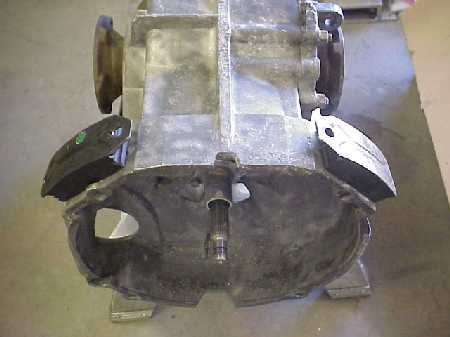 |
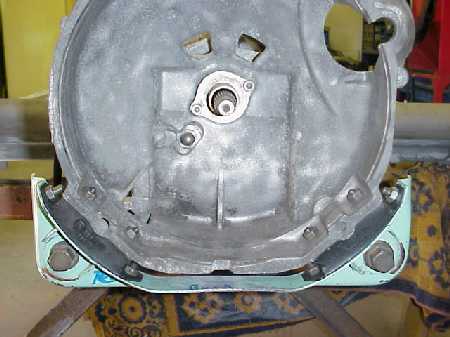 |
The nice thing about performing the rear mount adaptation first is that it gives you a static point to work off of for fitment to the VW pan. Now the transaxle can be coupled to the floorpan.
Step 2: Clearancing and Fitment
When you first lift up the 901 and try to fit it using the rear mounts as reference to where it needs to be, you will begin to realize how much larger and longer the 901 really is! Place a straight edge parallel to the ground and on top of the input shaft as a reference, then measure to the torsion tube one foot from the center on each side. With the beetle trans this measurement was 22.75 inches. It is important to have the 5 speed as far forward as possible because it is about 1 inch longer than the beetle trans. It’s far easier to modify the car to accept the new 901 location then modifying the body for an engine that sits 1″ further back! Clearance the frame horns for the sides of the gearbox and for the clutch tube bracket off the side of the box. Mark the areas to be clearanced using a paint pen or marker. It is good to clearance as little as possible to keep some strength in the frame horns. The input for the shifter on the 901 exits the bottom of the trans rather than the middle like a beetle. A hole must be cut into the bottom of the pan. In order to get the rear of the 901 as close to 22.75″ back from the torsion tube. Also lightly clearance the front of the trans and also the torsion tube. Do not remove any more material than necessary!
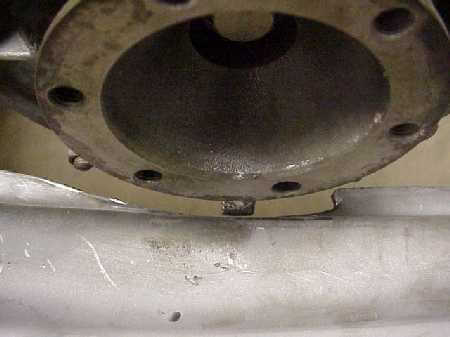
Clearancing for clutch bowden tube bracket |
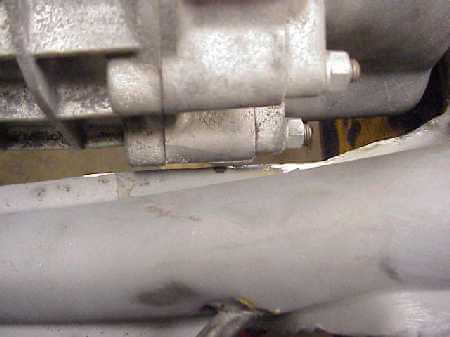
Clearancing for right-front of trans case |
Step 3: Fabricating the Front Mounting System
With the rear mounts bolted down and a floor jack supporting the front of the trans, you can begin to figure out the front mounting system; you can’t buy this stuff, you have to make it! Keep using the straight edge on the bell housing and measure to the torsion tube to keep the bell housing parallel and square. It is helpful to have the floor pan upside down at this point for obvious reasons. It is possible to adapt the original 911 front mount. In this conversion, I elected to build my own mount system because the 911 mount needed over four inches added to its width to fit the way I wanted. I determined that a mount built from scratch would look and fit best. I used Volvo trans mounts. These are quite generic and I found at least four different brands. I selected the hardest rubber versions for maximum rigidity. These mounts will also make it simple to swap in solid aluminum mounts for the strip just like the Gene Berg intermediate mount. I welded ears to the outside of each frame horn for the Volvo trans mount studs to bolt to. With the mount position determined, and the trans in a static position, build a front mount.
|
|
|
|
Note the clearancing to the trans case |
Bottom view of fabricated front trans mount |
Step 4: Modifying the Frame Tunnel and Adapting the Shift Linkage
Now that the trans is located where it’s new home is going to be, it is time for shift linkage! There are three options for shift linkage. Adapt the Porsche parts, adapt the VW parts, or full custom. I chose to use the 911 components to have a proper reverse lockout and to retain the “Porsche Look”. It is hard to mistake the 911 shift lever!
The parts needed are the shifter, the shifter to shift rod connection link, the actual shift rod, and the special rear coupler. Pelican Parts sells the Porsche bushings to tighten everything up, and they are essentially the Aircooled.Net equivalent in the aftermarket Porsche parts business (good guys who know their stuff).
The first step is to modify the frame tunnel so that the 911 shifter can bolt down. It is best to have the actual clip of the tunnel from a 911 but I didn’t have this option. The 911 shifter uses two front bolts and one rear. The tunnel is flat and wide enough for the rear mounting bolt to fit; simply drill and tap. The front, however, is more of a challenge! The tunnel curves down too abruptly for the shifter to bolt down. The solution is to weld in some material to box this area in. Cut pie like slits into the metal needing to be boxed in. Next, pull the metal out and using body tools form it into a box shape. Next, a scrap piece of 14 gauge steel was welded in. Weld up the pie cuts and the piece of strip steel then dress it all up so it doesn’t look like you are some hack. 🙂
|
|
|
|
|
|
Repeat the above outlined shifter flange steps again for the right side of the tunnel. The curve of the tunnel and shifter flange area is less abrupt on the right side so less work is required. With this step finished the shifter now bolts down to the frame tunnelj, and would make Dr. Porsche proud!
Step 5: Connect the Shifter to the Transaxle
The Porsche shift rod is a much nicer piece than the Beetle shift rod. The Porsche rod has a pivoting rear coupler with splines that telescope in the actual shift rod for for/aft adjustment. The front of the shift rod uses a right-angle link piece that connects it to the bottom of the shifter. The shift rod is almost six inches too short to work right from the start with a 68+ pan (remember early pans have the shifter further foward). It also does not have enough S-bend down to interface with the transaxle. The rod must both be S-bent down and also lengthened.
<
|
|
|
|
|
|
Once you have the tweaked shift rod installed inside the tunnel it is time to build a shift rod bushing support. I bought a new shift rod bushing from Pelican Parts and built a sheet metal bracket to hold it in place. The bracket has to be welded inside the tunnel exactly like the stock beetle support. You can’t use the beetle part because the 911 shift rod is 1″ OD vs. the Beetles .75″ OD (approximate, actual numbers are metric). I cut a window in the side of the tunnel to position the shift rod support, and welded it in place, then welded up my access window. It helps to drill holes through the top of the tunnel and spot weld through them (welding upside down through the window cut in the side of the tunnel isn’t easy).
|
|
|
|
|
|
Now the shifter is installed, the shift rod is in place and positioned in the bushing and all is hooked up. At this point your shift rod will probably be a bit too long or two short to work. It needs to be fine tuned. We carry an adjustable shift coupler which solves this problem. It works just like an adjustable pushrod so that you can have a small amount of adjustment. You can purchase one or built your own.
Hopefully you can get all five gears plus reverse now!
Step 6: Axles and CV Joints
You can use stock length axles with the 901 because it is close to the same width as a stock transaxle (unlike a Bus tranny conversion). At least this makes the conversion easy in this one respect! The flanges on the early 901 transaxles are sized the same as a Beetle T1. The difference is they have four bolts and two dowels. The easiest solution here is to Timesert the flange so that it uses six bolts. This must happen if using the early small flanges or the late 911/01 (930 size) flanges. It is also possible to weld, drill, and tap the holes which formerly hosted dowel pins. The last choice is to drill out the CV joints and use dowel pins, but the simplest way is to just Timesert the flange.
|
|
|
Option 1:
901 flanges, stock beetle CV Joints inside and outside, stock beetle stub axles, and stock beetle axles. It doesn’t get much simpler than that!
Option 2:
901 flanges, Racing beetle axles, Porsche CVs on the inner, and Bus CVs on the outer. To use Type 2 (Bus) outer CVs you need early Porsche 944, Type 181, or aftermarket stub axles. The outer T2 joint is slightly thicker. The solution is to machine the joint to a thinner dimension, modify the axle, or just buy full floating beetle length Racing axles which don’t have the problem (because of full floating splines).
Option 3:
911/01 flanges, conversion beetle length axles with Porsche splines (unlike the above two choices which are VW splines), 930 joints, and Chromoly conversion stub axles. This is the strongest solution, but also the most expensive and heaviest.
We hope you enjoy this original article written by Aircooled.Net Guest Tech Writer, Steven Arndt – Please send any questions, comments, or suggestions to Steve via email to akt@cableone.net
article posted: May 29, 2003
article edited by ACN staff: Feb 25, 2012
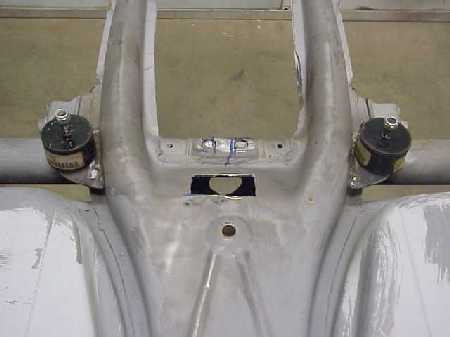
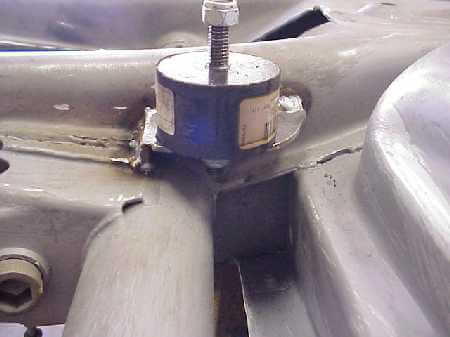
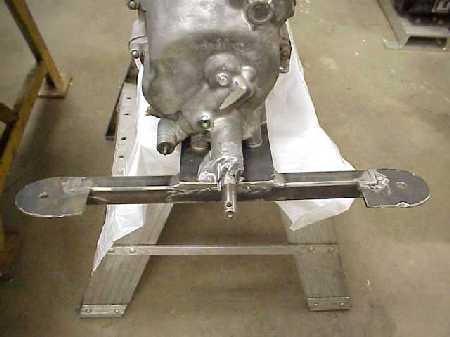
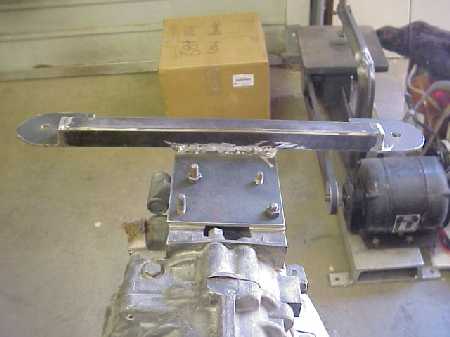
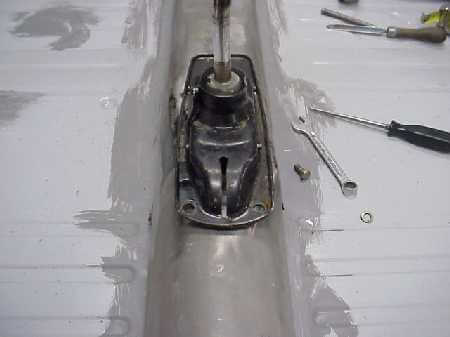 The problem: flat shifter base-flange vs. round tunnel
The problem: flat shifter base-flange vs. round tunnel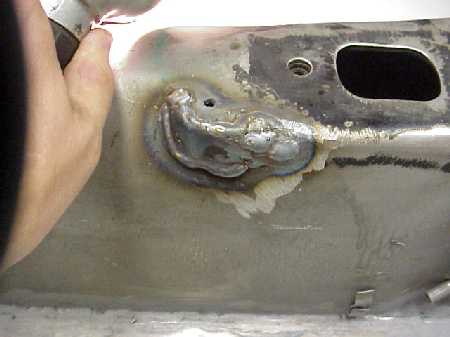 Tunnel boxed in, rough
Tunnel boxed in, rough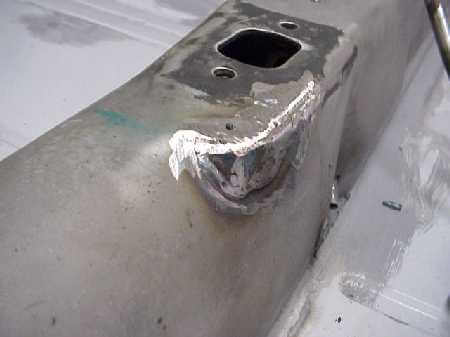 Here the welds are ground smooth
Here the welds are ground smooth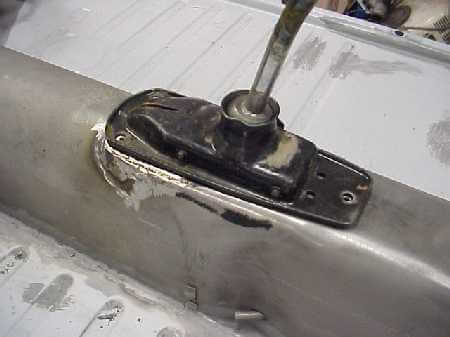 The shifter now fits the tunnel!
The shifter now fits the tunnel!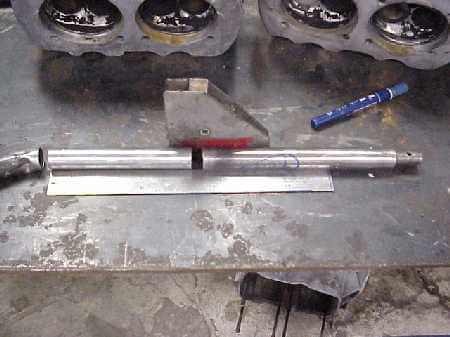 5.5″ length of 1″ OD pipe to extend the shift rod.
5.5″ length of 1″ OD pipe to extend the shift rod.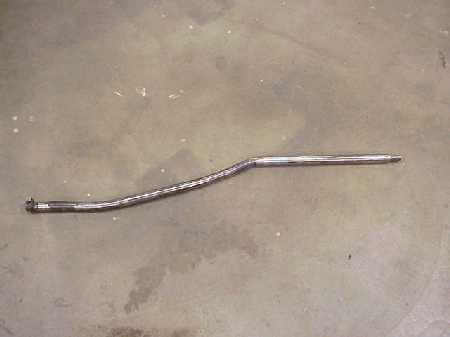 The shift rod after S-bending and lengthening.
The shift rod after S-bending and lengthening.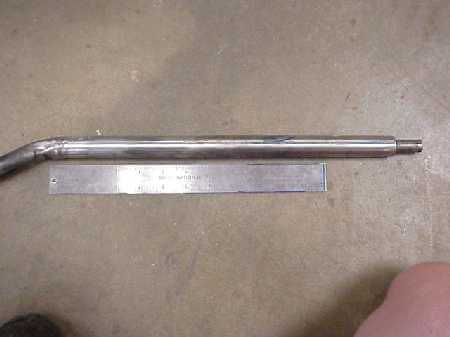 Close-up picture of the extra length welded in.
Close-up picture of the extra length welded in.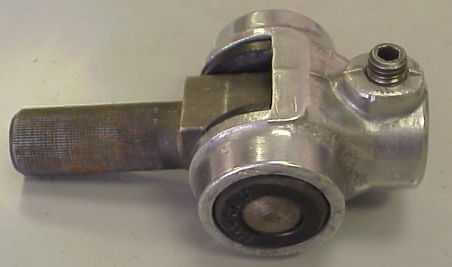 Polished 911 rear shift coupler with new rubbers
Polished 911 rear shift coupler with new rubbers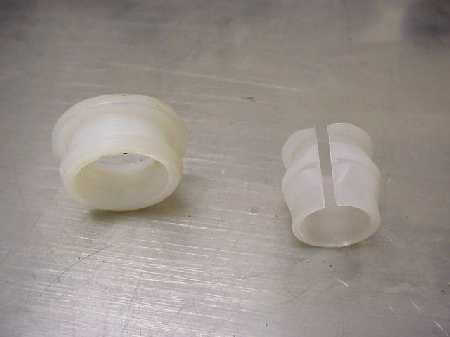 911 shift rod bushing left, Beetle right
911 shift rod bushing left, Beetle right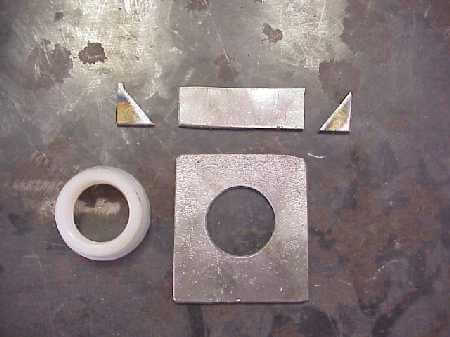 Layout the pieces for the new bushing support
Layout the pieces for the new bushing support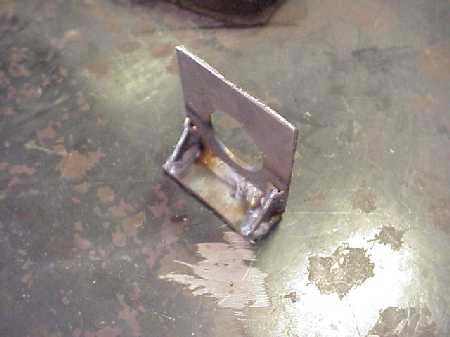 Fabricated shift rod buhing support to be welded into the tunnel.
Fabricated shift rod buhing support to be welded into the tunnel.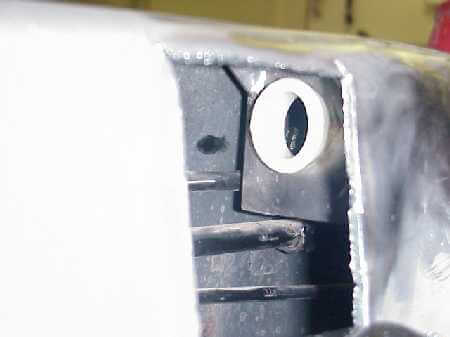 Bushing support tach welded in place.
Bushing support tach welded in place.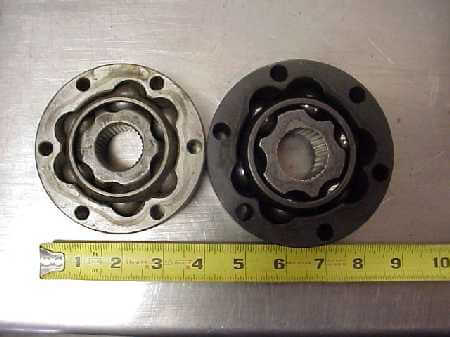 T-II on the left and Lobro 930 on the right.
T-II on the left and Lobro 930 on the right.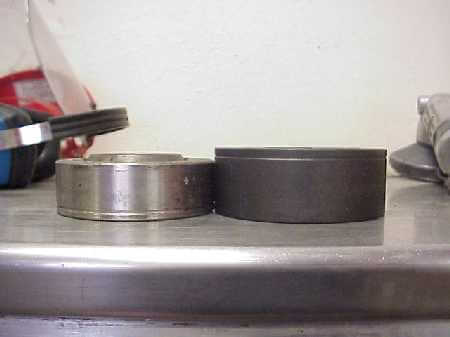 T-II left, 930 right. 930 CVs are thick!
T-II left, 930 right. 930 CVs are thick!